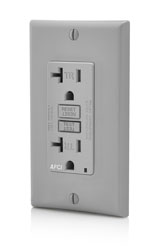
An Arc Fault Circuit Interrupter or AFCI is a type of electrical outlet or circuit breaker that trips when it detects a potentially dangerous electrical arc. Arc faults in homed are one of the leading causes of electrical wiring fires nationwide.
Sometimes confused with its common cousin, the Ground Fault Circuit Interrupter or GFCI, the purpose of an AFCI is to prevent electrical fires from “arcing” whereas a GFCI is to prevent electric shocks from poor grounding. Both serve an important purpose in reducing injury or saving lives.
An AFCI distinguishes between a harmless arc occuring in normal operation of switches, plugs, and motors, with an undesirable arc that occurs for example, in a hair dryer that has a broken wire in the cord and can lead to a fire.

AFCI breakers have been required for circuits feeding electrical outlets in bedrooms of homes by the electrical codes for many years. Since 2014, U.S. code has increased requirements to extend to outlets in most rooms of new homes.
AFCI’s commonly come in two forms; receptical, and a circuit breaker style that is located in a breaker box. Although circuit breaker style AFCI’s look similar to conventional circuit breakers which only respond to overloads and short circuits, AFCI circuit breakers also protect against arcing conditions that may lead to a fire.
When an AFCO trips at a receptical, it is not difficult to track down the issue, often being a defective appliance. But when a AFCI trips at a circuit breaker level, it can be a tedious and time consuming task to track down the specific location of the fault that is automatically tripping the breaker. However since the AFCI circuit breaker is protecting just one circuit, at least that narrows down the troublesome circut so only items on that circuit need to be checked rather than the entire home.
If you are having problems with AFCI’s in your home, please call us and let us help you fix the issue and help protect your family and home.
